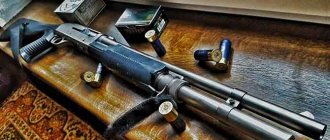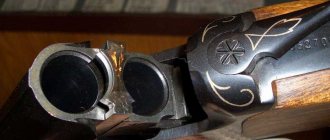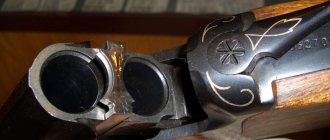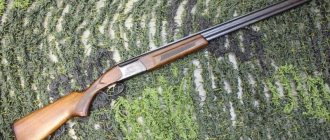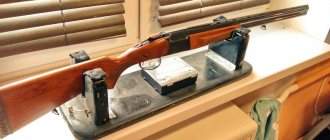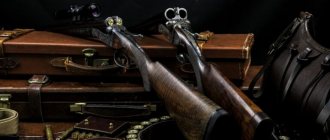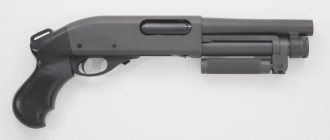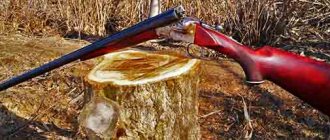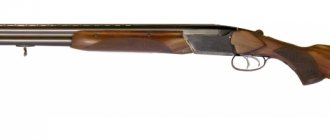Smooth-bore weapons are the most powerful type of self-defense weapon (civilian long-barreled firearms with a rifled barrel will be excluded from consideration, since in accordance with current legislation this class of weapons does not apply to self-defense weapons). With its help, a self-defender can solve almost all the problems facing him. Modern smooth-bore weapons can be divided into the following types: single-barreled, single-shot, double-barreled, pump-action and magazine-operated, semi-automatic. For self-defense enthusiasts, pump-action and semi-automatic shotguns are primarily of interest. Below is an overview of common (mostly domestic) shotgun models that you should pay attention to.
Currently, you can find a wide range of ammunition for smooth-bore weapons on sale, from hunting shotgun and slug cartridges to traumatic cartridges specially designed for self-defense, equipped with rubber bullets or buckshot. Keep in mind that the pellet or slug fired from a shotgun carries extremely high energy. A sheaf of shot fired from a short-range twelve-gauge shotgun is capable of cutting down a not very thin tree. A shotgun blast provides sufficient shock value even when partially impacted by a shot or buckshot load. Shooting 8mm buckshot from a 12-gauge shotgun with a full hit is equivalent to nine shots from a .32-caliber pistol. A rifle bullet pierces the metal door of a house at a distance of about 20 m; from the same distance, it can easily penetrate a car door, trunk and back seat of a car. A bullet fired from a 12-gauge shotgun from 20-25 meters knocks off door hinges and knocks the door lock off a metal apartment door. A charge of large buckshot (diameter about 8 mm) pierces a car door, trunk and back seat at a distance of 15-20 m. Even a shot from a shotgun with a traumatic cartridge, intended for self-defense and implying inflicting a non-lethal wound on the attacker, can lead to death if hit in the torso at a short distance (about three meters). The demonstration of smooth-bore weapons can have a serious psychological impact on attackers, which can save the self-defender from actually using the weapon. No other type of self-defense weapon can provide such a psychological effect.
Let's look at some models of smooth-bore weapons.
Double-barreled trigger gun IZH-43K
Caliber - 12x70; Barrel length - 510 mm; Choke constrictions 0.0/0.0 mm; Weight - no more than 3.3 kg.
The trigger double-barreled shotgun IZH-43K is perhaps the simplest (not counting the single-barreled shotgun) and at the same time quite effective from the range of smooth-bore weapons that are suitable for self-defense. Unlike a hammerless double-barreled shotgun, the hammer can be stored in a loaded state and completely ready for battle, which is an important circumstance for a self-defense fighter. It is also significant that such weapons are easier to use and reliable compared to pump-action and semi-automatic shotguns. The IZH-43K model is in fact not a true hammer: this gun is structurally classified as an internal hammer, and the external hammers act as cockers of the mainsprings and are not real hammers. But this does not change the matter: in circulation the IZH-43K corresponds to a conventional trigger. Not long ago, the Izhevsk Mechanical Plant began producing the true trigger IZH-43KN. For a self-defense fighter, the choice between IZH-43K and IZH-43KN is not particularly important; the main thing is the quality of a particular gun. And Russian factories produce civilian weapons that are extremely uneven in quality: someone will get a gun with virtually no flaws, another will have a crooked barrel, a third will have “glitchy” mechanisms, etc. In general, you should approach the choice of a specific gun thoroughly.
Operating principle
Reloading and cocking of the trigger mechanism is carried out by vigorously moving the forearm backwards and then returning it to its original place.
The gun can be loaded with one cartridge through the cartridge ejector window. If the hammer is cocked, then you need to unlock the forend by pressing the button on the left side of the receiver. After this, the forend is vigorously retracted. If the magazine is empty, then it, together with the bolt frame, is locked in the rearmost position. Before placing the cartridge on the feed elevator, turn on the safety lock by sliding its button to the right; the red ring mark should disappear.
The ammunition is placed on the feed elevator, after which you need to press the bolt stop release button located on the right side of the receiver and vigorously move the forend forward. There are models in which this button is located on the forend.
Multi-shot small-sized shotgun TOZ-106
Caliber - 20x70; Barrel length - 250 mm; Magazine capacity - 2 rounds (additional magazine - 4 rounds); Length with folded stock - 530 mm; Length with the butt folded down - 820 mm; Weight - 2.5 kg.
A truly self-defense model of smoothbore weapons. A twenty-gauge bolt-action repeating shotgun. The weapon has an extremely short barrel; This is the most compact model of firearms allowed for civilian use in Russia. The barrel is chrome-plated; butt - folding; box-shaped quick-detachable magazines. TOZ-106 is an inexpensive weapon: you can buy it in a gun store for $120-150. However, the quality of the gun is unimportant: during its use, a number of problems may arise related to the tight movement of the bolt, misalignment and jamming of cartridges during reloading. When firing a gun, the magazine may suddenly fall out, which will only amuse the attackers (although this applies to using a 4-round magazine; when using a 2-round magazine, such problems usually do not arise). But all these factory defects are, in principle, not difficult to eliminate even at home. In any case, after purchasing the TOZ-106, you need to think about the possibility of tuning it. Despite everything, the TOZ-106 gun is very popular in Russia, and the demand for it is quite high.
Disassembly
- Make sure the gun is unloaded.
- Unscrew the front swivel together with the shaped nut.
- Using a needle located under the cap of the shaped nut, press out the trigger mounting pin and remove it from the receiver.
- Separate the barrel assembly with the forend, bolt frame, bolt and magazine from the base of the trigger with the butt.
- Move the forend so that the bolt frame moves back. Separate the barrel from the block, remove the forend.
- Pull the rod and remove the bolt frame with the cylinder from the receiver cover.
- Separate the frame from the cylinder by pressing the ejector bevel, simulating locking the barrel (lift the lug tooth up) and move the cylinder back, while simultaneously lifting its shank up.
Pump-action shotgun TOZ-94
Caliber - 12x70; Barrel length 660/711 mm; Choke constrictions - 0.0 mm (for a 660 mm barrel), 1.0 mm (711 mm barrel), 0.0/0.5/1.0 mm (replaceable nozzles for a model with a barrel length of 660 mm); Magazine capacity 4 (7) cartridge(s); Gun length 1190-1250 mm; Weight - no more than 3.2 kg.
An inexpensive pump-action shotgun based on the TOZ-87, which inherited a good, very noble design from the prototype model. A multi-purpose gun that can be used for both hunting and self-defense. Several modifications of the gun are produced, differing in their design. The gun is generally not bad, it has a good action, but many users disapprove of the reliability of its mechanisms.
Story
At the end of 1994, the designers of the Tula plant (Russia) created TOZ-94. The prototype was the TOZ-87 gun. Most of the parts of both models are unified (this is the experience of foreign companies). Compared to the base model, the mechanisms and components have remained virtually unchanged. The reloading method has changed. A single-barreled pump action repeating hunting rifle was intended for commercial and amateur hunting and as a security weapon.
TOZ-194 is a pump-action shotgun, developed at the end of the last century in Russia. The weapon was intended for use in the protection of farm animals, forest areas, outbuildings and objects for various purposes, self-defense, and hunting.
The basis was the 94 model. The designers shortened the barrel, changed the configuration of the forend, and lengthened the under-barrel magazine. They abandoned the buttstock, replacing it with a pistol grip. The designers worked on the appearance and got a menacing “Terminator” version.
Semi-automatic shotgun TOZ-187
Caliber - 12x70; barrel length 540 mm; Choke constrictions - 0.0 mm, or a set of nozzles 0.0/0.5/1.0 mm; Magazine capacity 7 rounds (a shortened magazine for 4 rounds is possible); The length of the gun with the butt folded is 830 mm; Weight - no more than 3.2 kg
A gun intended for self-defense or security purposes. A semi-automatic machine based on the TOZ-87, which in appearance has very little resemblance to the prototype model. The main drawback inherited by this gun from the TOZ-87 is the insufficiently reliable operation of the mechanisms, hence the frequent delays in shooting; therefore, the TOZ-187 cannot be called a good self-defense shotgun.
Safety precautions when handling a gun
5.1 Any firearm, despite the presence of various safety devices in it, poses a DANGER TO PEOPLE’S LIFE AND HEALTH if handled carelessly. Take all precautions and remember that neglecting safety rules can lead to tragic consequences.
ALWAYS CONSIDER THE GUN LOADED AND READY TO FIRE.
5.2 Before any actions with the gun (smooth release, cleaning, disassembling, screwing in and unscrewing the choke, etc.), ALWAYS make sure that the gun is unloaded.
ALWAYS store and carry your firearm unloaded.
ALWAYS unload your firearm before entering a home, any building or tent, or entering a vehicle or boat. Never attempt to load or unload a firearm inside a vehicle or building (other than a shooting range).
When receiving a firearm from another person, you must open the gun and ensure that the chambers are empty. NEVER take anyone's word for granted that the gun is unloaded.
5.3 Even if the gun is not loaded, NEVER point it at people or objects that you do not intend to shoot at. When loading, unloading, servicing or cleaning a gun, always ensure the barrels are pointed in a safe direction, NEVER keep your finger on the trigger.
NEVER leave a weapon where it could fall and fire.
5.4 When shooting, NEVER release the safety until the gun is pointed at the target and you are ready to fire. While aiming, do not keep your finger on the trigger until you are ready to fire. Learn to keep your finger on the trigger guard and not on the trigger itself.
5.5 NEVER pull the muzzle of the weapon towards you. NEVER place your hand on the muzzle of a weapon.
5.6 You should always be aware of where you are shooting and what is behind the target. Before shooting, ask yourself the question: where will the shot or bullet hit if it goes right through or past the target. ATTENTION! The bullet can retain enough energy to injure a person at a range of up to 4 km.
NEVER shoot at hard flat surfaces or water as there may be ricochet.
5.7 NEVER try to upgrade your weapon. Do not attempt to reduce the trigger pull or remove the safety or any internal safety mechanism as this may result in accidental discharge.
5.8 Do not fire a gun with cartridges that are not intended for it. It is prohibited to change the weight of gunpowder in factory-made cartridges or change the mass of the shot or bullet.
5.9 Do not shoot cartridges and powders that have been stored for more than 4 years.
5.10 When loading cartridges, use high-quality components and follow the equipment standards specified in the instructions supplied with the gunpowder. When loading cartridges with smokeless powder, determine the mass of the charge only by weighing!
NOT RECOMMENDED:
- use any non-hunting powder, as well as a mixture of black and smokeless powder, as this can lead to swelling and rupture of the barrels;
- compress a charge from smokeless hunting powder.
5.11 Monitor the quality of the cartridges to avoid the loss of shot from the cartridge case into the bore and the local “pea-shaped” swelling caused by this. Carefully secure the cardboard spacer of the shot shell when using metal shells; use paper shells only once; do not reload factory-made cartridges.
5.12 Do not shoot from a smooth barrel a bullet whose body diameter is greater than the diameter of the bore in the choke area. The diameter of a round bullet should be 0.2...0.3 mm less than the diameter of the muzzle. The diameter of a bullet with external ribs should be 0.1...0.2 mm less than the diameter of the bore, and the diameter of the body of such a bullet should be 0.8...1.0 mm less than the diameter of the channel at the muzzle.
ATTENTION! Do not use caliber bullets made of hard materials - brass, steel, etc.
5.13 Be careful with ALL ammunition. Even blank cartridges can be dangerous at close range.
5.14 Before loading, inspect the barrels of the gun, make sure that they are not clogged with snow, dirt, or forest debris. Shooting a gun with clogged bores can cause the barrels to swell and even burst.
5.15 ATTENTION! If the trigger does not fire, continue to hold the gun toward the target for one minute. Sometimes the slow firing of the primer leads to a so-called “lingering” shot, when the shot occurs with some delay. If it still does not fire, unload the weapon while holding the barrel in a safe direction with the muzzle and chamber pointing away from you.
5.16 If the sound of a shot is noticeably different from previous ones, stop shooting immediately. Unload the gun and inspect the barrel, frame and other parts.
If you find any cartridge components stuck in the bore, clean it out before continuing to fire.
The bullet or wad may be far down the barrel where it is not easily visible, so use a cleaning rod to check. If anything is in the bore, NEVER attempt to remove it by firing another cartridge, even if you intend to use a blank cartridge or a cartridge from which the shotshell or slug has been removed. With this method, damage to the barrel and even serious injury to the shooter are often inevitable.
If swelling of the barrel, malfunction of the mechanisms, rupture of the bottom of the cartridge case or any damage to parts of the gun is detected, it must be sent to a workshop for examination and repair. If you find these defects, NEVER TRY TO SHOOT AGAIN!
5.17 ATTENTION! Ammunition containing lead is used to fire a gun. As is known, the presence of lead in the body can lead to serious damage to health. This risk is exposed not only to those who operate the gun, but also to those around it during shooting, when servicing and cleaning the gun. Therefore, when shooting and cleaning your gun indoors, ensure proper ventilation. When cleaning your firearm, protective measures must be taken to avoid contact with lead and lead compounds. After servicing the gun, wash your hands thoroughly.
Pump-action shotgun TOZ-194
Caliber - 12x70; Barrel length 540 mm; Choke constrictions - 0.0 mm, or a set of nozzles 0.0/0.5/1.0 mm; Magazine capacity 7 rounds (a shortened magazine for 4 rounds is possible); The length of the gun with the butt folded is 805-815 mm; Weight - no more than 3.2 kg
A gun intended for self-defense or security purposes. Pump engine based on TOZ-94. Just like TOZ-187, TOZ-194 is very different in appearance from the prototype model and has a brutal Terminator design. Compared to the TOZ-187, this shotgun is undoubtedly more reliable, and this model should not be overlooked, especially if you are a fan of such weapons.
Pump-action shotguns IZH-81, IZH-81KM
There are many modifications of the gun. Caliber - 12x70, 12x76; Barrel length 560/600/700/750 mm; Choke constrictions 0.0/0.5/1.0 mm; Under-barrel tubular magazine for 4-7 rounds or box-shaped (for 5 rounds); Options with a permanent butt, with a pistol grip and a folding butt, with a pistol grip without a butt. Materials: walnut, beech, birch, plastic.
IZH-81 is the most popular domestic pump-action engine. The weapon is quite reliable, unpretentious, and inexpensive. A multi-purpose shotgun that can be used for self-defense and security purposes, as well as for hunting, however, exclusively security and self-defense modifications are also produced. In general, IZH-81 is a good option for a self-defense fighter.
Semi-automatic shotgun MP-153
Caliber - 12x76, 12x89; Barrel length 600/700 mm; Choke constrictions 0.0/0.5/1.0 mm; Under-barrel tubular magazine with a capacity of 4 (6) rounds; Total length - 1230 mm (for a 700 mm barrel); Weight 3.6 kg.
MP-153 is a semi-automatic hunting rifle, the first semi-automatic machine mass-produced by the Izhevsk Mechanical Plant. During its short history of existence, the MP-153 shotgun has established itself as a reliable machine, operating very reliably when using various cartridges, including those with reduced charges, as well as self-rolling cartridges of rather rough manufacture, which not even every imported self-loading machine can boast of. But the MP-153 is primarily a hunting gun, not a self-defense one, but it can be considered as a multi-purpose weapon, intended, among other things, to solve security problems. Among the shortcomings of the MP-153, one can note a somewhat rough design, as well as frequent cases of defects in the manufacture of individual components; Also, the gun is a little heavy for running hunts.
MP-133 pump-action shotgun
Caliber - 12x76; Barrel length 540/600/700 mm; Choke constrictions 0.0/0.5/1.0 mm; Under-barrel tubular magazine (for the MP-133K model - replaceable box-shaped) with a capacity of 4 (6) rounds; Total length - up to 1230 mm; Various butt options (classic, folding, without butt - with pistol grip); Weight - up to 3.3 kg.
A newer development of the Izhevsk Mechanical Plant is a pump-action shotgun based on the IZH-81 and MP-153. Manufacturers have introduced new solutions to the design of the gun, ensuring, above all, greater safety in handling the weapon. MP-133 is a good option for a self-defense fighter.
Recommendations for using the gun
4.1 Open and close the gun smoothly with both hands. Sharp opening and closing of the barrel loosens its connection to the box. When closing a new gun, until the mechanism has worked in, the locking lever may not reach the central position; in this case, it must be adjusted by hand.
4.2 Do not use cartridges that fit tightly into the chambers, that is, requiring great effort when closing and opening the gun.
4.3 Do not idle the triggers - this reduces the service life of the strikers, their springs and the pins that secure the strikers. If you need to simulate a shot, insert an unloaded cartridge case with a spent primer into the chamber.
4.4 Do not shoot the gun with primers alone without powder, because... combustion products of the explosive mixture of primers spoil the bores.
4.5 Avoid hitting the gun barrels - this will cause dents and deteriorate the accuracy and accuracy of shooting.
4.6 Periodically tighten the screw securing the butt to the frame during shooting, especially during the initial period of operation of the gun, to prevent the butt from rolling.
4.7 In the case of using cartridges different from those used during control shooting at the enterprise, additional zeroing of the gun may be necessary.
To shift the midpoint of impact horizontally to the right, you need to move the rear sight to the right; to shift the STP to the left, you need to move the rear sight to the left. Once the adjustment is complete, tighten the screw that secures the rear sight. To move the STP vertically up, you need to screw in the front sight, and, conversely, to move the STP down, you need to turn out the front sight. Rotate the fly until it is fixed with a bend.
It is not recommended to carry out any manipulations with the STP convergence mechanism (if available).
4.8 For shotguns with replaceable choke tubes, follow these recommendations:
ATTENTION! WHEN ANY MANIPULATIONS WITH REPLACEABLE CHOZZES - CHANGING THE chokes, CHECKING THE TIGHTENING IN THE BARREL, VISUAL CONTROL - BE SURE TO MAKE SURE THAT THE GUN IS UNLOADED!
ALWAYS CHECK BEFORE SHOOTING AND AFTER EACH CHANGE OF THE CHOKE THAT THE CHOKE IS FULLLY TIGHTENED. Tighten the replaceable choke using a special wrench attached to the gun.
If the replaceable choke constriction is not screwed in enough, a breakthrough of powder gases into the gap between the barrel and the constriction is possible, which leads to deformation of the muzzle of the barrel and the replaceable choke constriction, and can also lead to the constriction flying out of the barrel.
SHOOTING WITH AN UNDERFINISHED CHOZZLE CLEARANCE RESULTS IN ITS DESTRUCTION, DAMAGE TO THE GUN AND EVEN INJURY TO THE SHOOTER.
A properly installed replacement choke should be flush or slightly recessed relative to the muzzle of the barrel. The elongated muzzle constriction is screwed until the rear end stops into the ledge in the barrel bore, while there must be a gap between the end of the barrel and the protruding cylindrical part of the muzzle constriction;
— after screwing in the replaceable choke, inspect the barrel bore from the muzzle side, and the ring should be visible at the junction of the end of the constriction and the ledge in the barrel bore, that is, the surface of the barrel bore should protrude above the surface of the replaceable constriction.
Violation of the integrity of the ring indicates mechanical damage to the constriction (bruising, bending of the edges) or the seat in the barrel; in this case, during shooting, damage to the replaceable choke or gun may occur.
SHOOTING WITH A DEFORMED REPLACEABLE MUZZLE CLEARANCE RESULTS IN ITS DESTRUCTION, DAMAGE TO THE GUN AND EVEN INJURY TO THE SHOOTER.
— when using the gun, periodically (after about 50-100 shots) check the tightness of the muzzle narrowing and, if necessary, tighten it;
— remember that replaceable choke constrictions and seats for them require careful handling in order to prevent accidental deformation of thin-walled sections. When transporting or operating the gun, do not leave the barrels without screwed-in choke constrictions.
4.9 Before storing the gun, release the triggers smoothly. After separating the barrel block from the box, in order to return the locking lever to the central position, it is necessary to press on top of the locking bar delay located in the groove of the box where the breech of the barrel is installed.
Store the gun in a dry place.
Semi-automatic shotgun Saiga-12
Caliber - 12x76; Barrel length - 430/580 mm; Choke constrictions 0.0/0.5/1.0 mm; Removable box magazine with a capacity of up to 8 rounds; Total length - up to 1150 mm; There are modifications with a folding stock; Weight - 3.5-3.8 kg.
"Saiga" is a series of semi-automatic shotguns created on the basis of the legendary AK (Izhevsk). These shotguns are usually positioned in stores as hunting shotguns, but in fact they are pure assault shotguns, intended primarily for solving tactical problems. “Saiga” is the favorite weapon of Russian self-defense fighters, distinguished by its “military” style design and fairly high reliability. The shotgun is available in many modifications, including with a folding stock, an adjustable rib, interchangeable choke tubes, and barrels of various lengths. In addition to the Saiga-12 series, less powerful guns of the Saiga-20 and Saiga-410 families are produced, in 20 and 410 calibers, respectively.
Saiga smoothbore shotguns are currently the most popular domestic semi-automatic rifles, which have rightfully won the trust not only of the residents of Russia, but also beyond its borders. Saiga-20K in the car is always ready to help the car owner in case of a dangerous situation; Saiga-12 with a magazine loaded with eight Magnum cartridges will help you welcome the enemy within the walls of your home; Saiga-410K-02 on the shoulder of a self-defender will support him when entering a dark entrance.
Design and principle of operation
3.1 The barrels are locked in the box using a locking bar. The locking unit is controlled using the locking lever located at the top of the box. When the barrels are open, the locking bar and locking lever are held in place by a locking bar delay, which automatically releases the bar when the barrels are closed. The removable forend is secured to the receiver block with a lever-type latch.
3.2 The barrels in the receiver block are located in a vertical plane: smooth at the top, rifled at the bottom. The barrel block can be manufactured in three designs:
— the barrels are connected by muzzle and breech couplings and have a mechanism for bringing together the average points of impact of the barrels, sighting devices are made in the form of a rear sight and a front sight;
— the barrels are connected by muzzle and breech couplings without a mechanism for bringing together the points of impact of the barrels, the barrel block has a ventilated aiming rib, rear sight and front sight;
- the barrels are connected using a breech coupling and inter-barrel strips without a mechanism for bringing together the points of impact of the barrels; the barrel block has a ventilated sighting strip, rear sight and front sight.
The adjusting rod in the mechanism for bringing together the average points of impact (MIP) is selected by diameter at the manufacturer when zeroing the gun in such a way as to align the MIP of the barrels. When connecting barrels with couplings without interbarrel strips, the lower barrel in the muzzle coupling is installed with a guaranteed gap, which prevents the displacement of the STP of the barrels due to uneven heating during intensive shooting from one of them.
3.3 Sights - adjustable. The rear sight is adjustable horizontally and secured with a screw. The front sight is adjustable vertically and secured with a spring-loaded clamp. On the ridge of the breech coupling there is a dovetail-type seat for attaching the optical sight bracket. The additional smoothbore barrel block is equipped with a ventilated sighting rib.
3.4 The cartridges are pulled out of the chambers by the ejector when the barrels are opened.
3.5 The impact mechanism is trigger-type, the return triggers (“with release”) are made separately from the strikers. Mainsprings are cylindrical screw. The hammers are cocked and the mainsprings are compressed by a hinge, cockers and pushers when the barrels are opened.
3.6 The trigger mechanism can be manufactured in two designs:
- with a direct firing sequence, characteristic of double-barreled shotguns, when the front trigger is used to fire a shot from the lower (rifled) barrel, the rear trigger is used to fire a shot from the upper (smooth) barrel;
- or with the reverse firing sequence: the front trigger is used to fire a shot from the upper (smooth) barrel, the rear trigger is used to fire a shot from the lower (rifled) barrel.
3.7 The fuse, located at the top of the box, is automatic and turns on every time you turn the locking lever. The fuse is turned off by moving the button forward. When the safety is turned on by moving the button back with the triggers pulled, the sears do not lock. When you subsequently cock the triggers (open the barrels), the fuses automatically lock the sear.
The trigger mechanism has additional safety devices (interceptors or hammer interceptors) to prevent a shot when the hammers are accidentally released from the cocking action without pressing the triggers, for example, when the gun is dropped.
3.8 The gun has the ability to smoothly release the triggers. To do this, with the barrels open, move the safety button to the forward position, press both triggers and smoothly close the barrels.
ATTENTION! TO AVOID AN ACCIDENTAL SHOT, IT IS RECOMMENDED TO REMOVE THE CARTRIDGES FROM THE CHAMBERS BEFORE PERFORMING THIS TECHNIQUE!
Remington 870 pump action shotgun (USA)
Caliber - 12x70, 12x76; Barrel length from 355 to 533 mm depending on the model; Under-barrel tubular magazine with a capacity of 5 to 7 rounds; Weight up to 3.5 kg.
The Remington 870 is a legendary classic pump-action shotgun that has been in production for over 50 years and has gained great popularity around the world. This is a multi-purpose gun, which is used by the police, security agencies, and occupies a prominent place in the arsenal of the hunter and self-defenseman. There are many modifications of this weapon, differing in barrel length, materials used, the presence of additional accessories, etc. The Remington 870 can also be found on the Russian market, and the amount of about $700 that you will have to pay for this gun is money that will clearly not be wasted.
Old passport
Below are the passport pages of guns from earlier years of production.
Read cyber fiction online on Phantom Worlds
Protecta assault shotgun (South Africa)
Caliber - 12x70; Barrel length - 304 mm (there are modifications with a longer barrel length); Magazine capacity of 12 rounds (for Russia - 10); Folded length - 500 mm; Length with the butt folded down - 800 mm; Weight - 4.5 kg.
Protecta is a very serious weapon that has found use in the police and special forces. It is unlikely that anyone will doubt the seriousness of the intentions of the person holding such a monster in his hands. Due to its fairly high mass, the weapon has low recoil, which allows effective shooting from the shoulder, hand, and hip. Spent cartridges are ejected automatically. The main distinguishing feature of the weapon is the 12-round (for Russia the capacity is reduced to 10 rounds) rotating disk magazine; cartridges are loaded through a hole in the right rear side of this disk. A perforated metal casing protects the shooter’s hands from the barrel, which is hot when firing. The gun is compact, very reliable and does not require particularly careful maintenance. Protecta is available on the Russian market in limited quantities, and you will have to pay at least $1,000 for this weapon. For real gourmets, Protecta Gold is produced - a gun whose surface is tinted in a noble gold color; Such a thing will cost twice as much as a conventional modification.
Storage and care
It is advisable to store the gun in a dry place with normal humidity and temperature, in a special steel safe. As established by law.
Periodically, every three or four months, the gun must be cleaned and lubricated so that it serves for a long time and without failure.
After hunting, it is advisable to clean the barrel from carbon deposits and dirt, and be sure to clean the bolt frame and the bolt itself. After cleaning, wipe with a damp, oily rag so that the gun is lightly covered with an oil film, this prevents the formation of oxides.
